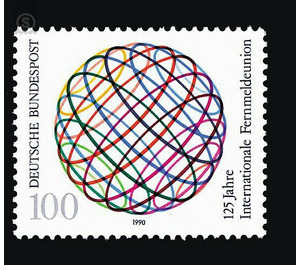125 years International Telecommunication Union - Germany / Federal Republic of Germany 1990 - 100 Pfennig
Theme: Communication & Media
| Country | Germany / Federal Republic of Germany |
| Issue Date | 1990 |
| Face Value | 100.00 |
| Color | white |
| Perforation | K 14 |
| Printing Type | 8-color offset |
| Stamp Type | Postage stamp |
| Item Type | Stamp |
| Chronological Issue Number | 1337 |
| Chronological Chapter | GER-BRD |
| SID | 21829 |
| In 42 Wishlists | |
History of the UIT: The UIT goes back to the World Telegraph Association, which was founded by the World Telegraph Agreement on May 17, 1865 in Paris. This treaty, which was signed by 20 European countries, including 7 German ones, for the first time laid down guidelines for the international operation of telegraphy facilities and fixed fees. With the introduction of radio telegraphy at the beginning of the 20th century, international agreements were also needed in this area, the coordination of which was carried out by the World Radio Association. This world radio club closed in Madrid in 1932 with the World Telegraph Association for the International Telecommunication Union. The Union has since been renamed Union Internationale des Télécommunications (UIT) or International Telecommunication Union (ITU). In 1947, UIT was integrated as a United Nations specialized agency under the umbrella of the United Nations. Currently, the International Telecommunication Union has 166 member countries worldwide. Tasks of the International Telecommunication Union: Telecommunications, now the biggest economic factor, demand sensible international coordination and administration. In particular, some of the natural resources (eg radio frequencies, orbital positions) are present only to a limited extent. The use of these resources must, however, be made possible for all countries, including the less technologically advanced, on the basis of equal rights. For example, UIT's mission today is to guarantee standardization in telecommunications in order to secure and develop international telecommunications, to coordinate frequencies and orbital positions, and to promote the development of telecommunications networks in less developed countries. Against this background, UIT's universally agreed principle of universality, which, with its key features, voluntariness, independence, equality and mutual support, forms an essential basis of UIT work that is not governed by public or private law Interests is hindered. Organs of UIT: The structure of the International Telecommunication Union is divided into permanent and non-permanent bodies. The permanent organs of the UIT are: - the International Frequency Registration Board (IFRB) for the registration and management of frequencies and satellite orbital positions, - the International Telegraph and Telephone Consultative Committees (Comitée Consultatif International Télégraphique et Téléphonique; CCITT) and the Radio Communications Committee (CCIR) for the development of standards and recommendations in close collaboration with research and industry, - the Telecommunications Development Bureau (TDB) for the Development of Telecommunications Telecommunications facilities in developing countries and promotion of technology transfer, - the General Secretariat for representation and for central cross-cutting tasks. In addition, there are the temporary bodies of the Union, which only meet on a temporary basis: - the Plenipotentiary Conference, which is the supreme decision-making body of the UIT. It meets every 5 to 9 years and adopts the basic work, the International Telecommunication Treaty, - the Board of Directors, which conducts the business of the Union between the Intergovernmental Conferences and meets once a year, - the world and regional administrative conferences for the elaboration of regulations for the various sectors of activity the member countries of the UIT. (Text: Federal Ministry of Post and Telecommunications, Bonn)


